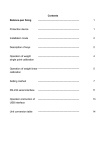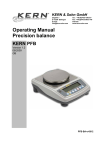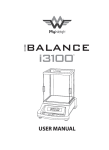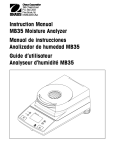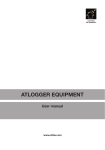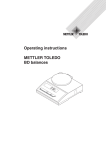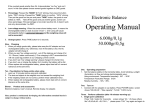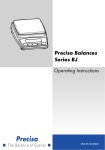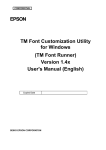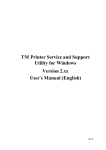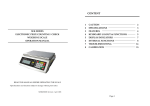Download JW User Manual
Transcript
JW SERIES HIGH PRECISION BALANCE OPERATION MANUAL PLEASE READ THIS MANUAL VERY CAREFULLY BEFORE ATTEMPTING TO OPERATE THE BALANCE JANUARY 2005 Specifications subject to change without prior notice CONTENTS CAUTIONS 1. INSTALLATION 2. SPECIFICATIONS 3. KEYBOARD LAYOUT AND DESCRIPTION 4. INITIAL SETUP 5. INSTRUCTIONS FOR USE 6. TROUBLE SHOOTING 7. DAILY CARE AND MAINTENANCE CAUTIONS 1. This unit is legal for trade only when it is sealed (and/or stamped) and bearing a serial number. Do not attempt to break the seal (or stamp) affixed to this balance or remove the serial number. Contact your dealer for more information and for after sales service. 2. For most accurate weighing results, do not use this balance where or when the environmental conditions fall beyond those listed in SPECIFICATIONS. Do not attempt to open this unit or conduct any troubleshooting other than those listed in TROUBLE SHOOTING. 1. INSTALLATION 1.1 Check and make sure that the following accessories are included: Operation Manual x 1 Balance x 1 Plastic platter x 1 Stainless steel platter cover x 1 Protection cover x 1 Windshield x 1 (for JW-250 & JW-500 only [JW-1000 optional]) Power adaptor x 1 Contact your dealer if any item is missing. 1.2 Insert the plastic platter into the balance carefully and secure with the screw provided before putting on the stainless steel cover. No excessive force is needed. Excessive force may damage the weighing sensor. 1.3 Power up the balance a. Before charging the balance or powering up with the adaptor supplied, please make sure the input voltage listed on the back of the adaptor matches with the local voltage. If not, do not use it and contact your dealer immediately. b. Before first time use, charge the balance for at least 8 hours to ensure the best performance. SPECIFICATIONS Model No. JW-250 JW-500 JW-1000 JW-2500 Tare Range Power-on Zero Range Zero Range Min. Load Weighing Units NOTE A Power Source Operating Environment Capacity Division (Max) (e) 250g 0.005g 500g 0.01g 1000g 0.02g 2500g 0.05g Full Tare Range Full Power-on Zero Range ±2% 20e Gram, ounce, pound, troy ounce, grain, penny weight, metric carat, momme, troy, tael, tola, dram By Built-in Rechargeable Battery or AC/DC Power Adaptor 0o~40oC (32o~104oF), Non-condensed. R.H.≦85% Specifications subject to change without notice NOTE A: To comply with the law of certain countries, some of the weighing units may be disabled. Contact your dealer for more information. 3. KEYBOARD LAYOUT AND DESCRIPTION 1. OFF KEY Press this key to turn scale off 2. ON/RE-ZERO KEY Press this key to a) turn balance on or; b) act as tare key to set weight displayed to zero Press and hold this key to turn backlight on and off 3. MODE KEY Press this key to switch among the weighing units available during operation. 4. SAMPLE KEY Press this key to sample the weight placed on the platter when engaging the counting function or percentage function 5. PERCENTAGE FUNCTION Press this key to enter the percentage function 6. COUNTING FUNCTION Press this key to enter the counting function or to move between count or weight display 7. ZERO INDICATOR This indicator appears to indicate a zero weight status 8. NET INDICATOR This indicator appears to indicate the tare function is in operation and weight displayed is net wei ght 9. MODE INDICATOR This indicator shows current weight unit or operating mode engaged “g” indicates the metric unit is being employed “Pct” indicates percentage function is being employed “PCS” indicates counting function is being employed With the scale off, hold down %/WT. key and press ON/RE-ZERO to switch on the balance. This area will indicate the function engaged: “F0” to set motion filter when at zero “F1” to indicate the span value “F2” to light up all the segments “F3” to select weight unit “F4” to set Auto Power Off Function “F5” to set baud rate for RS-232 “F6” to set motion filter when weighing 10. LO-BAT INDICATOR When this indicator appears, recharge the balance immediately. Failure to do so may cause unrecoverable damage to the rechargeable battery inside the balance 4. INITIAL SETUP 4.1.1 POSITIONING THE SCALE In order to obtain an accurate weighing result, the balance must be placed on a strong and level surface. If required, adjust the leveling feet underneath balance to obtain a level position. (Use the bubble level to assist with this) 4.1.2 SET UP WINDSHIELD (Top cover) x 1 (Window) x 2 (Sliding door) x 2 (Frame) x 2 (Bottom cover) x 1 The windshield consists of 8 illustrated in the above drawing. components as If any items are missing, please contact your local distributor for assistance. To set up the windshield, please follow the steps below: a. Slide the door sideways into one of the slots in the frames (door handle first as illustrated in the drawing) and click onto the bottom cover. The door should be able to slide in and out with the door stop and door handle acting as a retainer for the door b. Repeat the same procedure for the other sliding door and frame. Both frames with sliding doors should be securely fixed to the bottom cover now c. Remove the platter and place the incomplete windshield on the balance and fasten it with the screws provided d. Replace the platter gently e. Slide in the windows from the top for both sides of the balance Put on the top cover to complete the windshield setup 4.2 INTERNAL SETTINGS 4.2.1 Set Zero Motion Filter To ensure the best performance under a poor operating environment, the user can employ a motion filter when at zero. Follow the steps below. a. Turn balance off Press and hold %/WT., then press ON/RE-ZERO b. Balance displays the span value and F.1 Press %/WT. until the mode indicator displays F.0 Press MODE to select zero motion filter from 0 to 4. Motion filter is set at 0.5d apart: -Zero_0 for normal, in which any changes within 0.5d will remain at zero -Zero_4 for maximum effect, in which any changes within 2.5d will remain at zero Press %/WT. to confirm setup c. Turn balance off and on again and use as normal 4.2.2 Select A Weight Unit The balance is equipped with 10 weighing units. Follow the steps below to enable/disable these units. a. Turn balance off Press and hold %/WT., then press ON/RE-ZERO b. Balance displays the span value and F.1 Press %/WT. until mode indicator shows F.3 Press MODE to select the weighing unit according to the mode indicator Press PCS/WT. to turn on or off the selected units c. To set the unit shown when the balance is powered on, press SAMPLE when at the selected unit Press %/WT. to confirm setup d. Turn balance off and on again and use as normal 4.2.3 Set Auto Power Off Function The balance is equipped with an AUTO POWER OFF FUNCTION. Under this function, the balance will switch off automatically if it is not used for 4 minutes. Follow the steps below to enable/disable this function. a. Turn balance off Press and hold %/WT., then press ON/RE-ZERO b. Balance displays the span value and F.1 Press %/WT. until mode indicator shows F.4 Press MODE to shift between 0._OFF and 30._OFF -To enable the AUTO POWER OFF FUNCTION, press %/WT. when 30._OFF appears -To disable the AUTO POWER OFF FUNCTION, press %/WT. when 0._OFF appears f. Press %/WT. to confirm setup g. Turn balance off and on again and use as normal 4.2.4 Select RS-232 Baud Rate (For Computer Connection Only) This unit is equipped with 3 baud rates with default setting at 9600 and N.8.1. Follow the below steps to select the desired speed. a. Turn balance off b. Press and hold %/WT., then press ON/RE-ZERO c. Balance displays the span value and F.1 d. Press %/WT. until mode indicator shows F.5 e. Press MODE to select among br 48, br 96 or br192 f. Press %/WT. to confirm setup g. Turn balance off and on again and use it as normal 4.2.5 Set Weighing Motion Filter The weighing motion filter gives a more stable result when the operating environment is poor. Follow the steps below to set the motion filter. a. Turn balance off b. Press and hold %/WT., then press ON/RE-ZERO c. Balance displays the span value and F.1 Press %/WT. until the mode indicator display F.6 d. Press MODE to select zero motion filter from 0 to 4. Filt_0 provides the least effect and Filt_4 provides the maximum effect against poor operating environments Press %/WT. to confirm setup e. Turn scale off and on again and use as normal 5. INSTRUCTIONS FOR USE 5.1 BEFORE WEIGHING Make sure that: a. The platter is inserted correctly into the balance The balance is placed on a level and strong surface Apply windshield if necessary b. The balance is turned on The ZERO INDICATOR is on. If not, press ON/RE-ZERO to set display to zero. Refer to SPECIFICATIONS for maximum zero range 5.2 WEIGHING a. Always place a load onto the platter gently. Excessive force or shock may cause damage to the sensor inside balance b. The weight of the load will be displayed automatically c. It is good practice to remove all loads from platter after weighing. It will prolong the lifetime of the sensor inside the balance 5.3 SELECT WEIGHT UNIT Press MODE to shift among different weighing units with or without backlight. Refer to 4.2.2 for internal setting procedures. 5.4 TURN BACKLIGHT (OPTIONAL) ON/OFF Press MODE to shift among various weighing units (e.g. “g” without backlight or “g” with backlight) or press and hold ON/RE-ZERO to turn backlight on and off. Even though the backlight function is employed, backlight will be turned off: When a zero weight is detected and remains stable for 10 seconds, or When a weight remains stable for 20 seconds Backlight will be automatically turned on again when weight change is detected or a key is pressed. 5.5 SET DISPLAYED VALUE TO ZERO WHEN UNLOADED Press ON/RE-ZERO to eliminate a positive or negative value. After ON/RE- ZERO is pressed, the ZERO INDICATOR will appear. Refer to SPECIFICATIONS for maximum zero range. 5.6 TARE OFF THE WEIGHT OF A CONTAINER When a container is used, follow the steps below to tare off the weight of the container and obtain a net weight status. a. Remove all loads from the platter Make sure that the ZERO INDICATOR is on Place the container on the platter Press ON/RE-ZERO After ON/RE-ZERO is pressed, the TARE INDICATOR will appear. Refer to 5.2 for weighing procedures. Weight displayed is the net weight of the subject matter. Refer to SPECIFICATIONS for maximum tare range. 5.7 CLEAR THE TARE FUNCTION Remove all loads from the platter then press ON/RE-ZERO. After ON/RE-ZERO is pressed, the TARE INDICATOR will disappear. 5.8 COUNTING Press the “PCS/WT” key and the balance will display “0PCS”. Press the “SAMPLE” key and the balance will display S= 20 and “ADD” will flash. Select the sample you wish to apply by pressing “SAMPLE” (20, 50, 100, 200 or 500) Place items on the platter corresponding to the number shown in the display. The display will now show the sample size, e.g. 20 PCS. Add more items to the platter and the display will show the total count. To change the item weight, repeat the above procedure. To return to the weighing mode, press “PCS/WT” 5.9 PERCENTAGE MODE Press the “%/WT” key and the balance will display “0.0Pct”. Press the “SAMPLE” key and the display will show “P = 100.0 ADD”. Put the sample (100%) on the platter and the balance will beep and display “100.0Pct”. The balance is now prepared for percentage weighing. Put an object on the platter and the display will record a percentage of the original sample. To return to the weighing mode, press “PCS/WT” twice. 5.10 RECHARGE THE BALANCE When the LO-BAT INDICATOR appears, apply the power adaptor and recharge the balance immediately. Failure to do so may cause unrecoverable damage to the rechargeable battery inside the balance. balance can remain in operation when recharged. 6. TROUBLE SHOOTING Symptom Balance cannot be turned on The being Check: Is the balance charged? Action: Recharge the balance for at least 8 hours before first time use or plug in the power adaptor before turning the balance on. Check Is the power adaptor plugged properly into both the electrical outlet and the DC inlet of balance? Action: Secure both ends of the power adaptor and try again. 00000 Symptom Balance displays Check Is the load applied to platter in excess of the rated capacity of the balance? Action Remove all loads from platter and try again. Symptom Balance displays Check Is the platter inserted in the balance 00000 correctly? Action Insert the platter into the balance correctly. Symptom Balance turns off automatically Check Is the AUTO POWER OFF FUNCTION employed? Action Refer to 4.2.3 to disable the AUTO POWER OFF FUNCTION. Check Is the LO-BAT INDICATOR on? Action Apply the power adaptor and recharge the balance immediately. Symptom Rated capacity cannot be reached Check Is the TARE INDICATOR on? Action: Turn the balance off. Remove all loads from platter and turn on again. Check Anything obstructing the platter? Action Remove all obstacles. Symptom Weighing result is not accurate Check Is the balance positioned in a level condition? Action Adjust the leveling feet to obtain a level condition. Check Is the balance affected by airflow, vibration or RFI? Action: Place the balance disturbances and away apply from the all wind shield. Check Is the balance calibrated correctly? Action Contact your dealer. Check Is the correct weight unit employed? Action Refer to 4.2.2 and 5.3 for weight unit setting and usage. Symptom BALANCE TURNED ON BUT ZERO WEIGHT CANNOT BE ATTAINED Check Is the platter positioned correctly? Action Remove the platter and insert it again. Check Is any load applied to platter? Action Remove all loads from platter. Check Is the balance affected by air flow, vibration or RF? Action Position the balance away from all disturbances and apply the windshield. 7. DAILY CARE AND MAINTENANCE 7.1 Clean the balance with a soft and damp cloth. If necessary, apply a mild detergent. Do not pour water onto the balance. 7.2 Do not use any harsh, abrasive material, acetone, volatile solvent, thinner or alcohol for cleaning. 7.3 Verify the accuracy of the balance periodically. Re-calibrate the balance if necessary. NOTE: In some countries, calibration of the balance is restricted to authorized/qualified agents only. Contact your dealer for more information. 7.4 The balance must be placed in a horizontal position during transportation or long term storage. 7.5 Remove platter from balance before transportation or long term storage. 7.6 Store balance in a dry and clean place.






















